Adrian Collins's Blog, page 59
April 14, 2024
GdM Issue #38 featuring South Asian authors is here!
Last Updated on April 15, 2024
Grimdark Magazine Issue #38 is finally here! This is an issue that I am massively excited about as we try to push your boundaries as a reader through focussing on South Asian SFF. In Mihir Wanchoo’s introduction, he sums up the appeal of stories from South Asia when he says that the stories are “laced with magic, gods, rakshasas, mythical creatures, non-human races, prophecies, and more.” I think he nails the feel of what Beth has put together, perfectly.
Note from Editor Beth TablerThis issue developed over lengthy conversations with my good friend Mihir Wanchoo; Mihir is one of the lead voices from the famous review blog, Fantasy Book Critic. In the last few years, I have developed an insatiable love for the vibrancy of South Asian literature. This love is coupled with an interview with Gourav Mohanty, author of Sons of Darkness, where he talked about it being the first Indian grimdark novel. I knew that I could bring dark stories from South Asian writers to our readers and get them as enthralled with the storytelling as I am currently. I cannot wait for readers to dive into the stories of R.R Virdi, whose Reed Lions is our cover image, or the stories of Yudhanjaya Wijeratne, Vajra Chandrasekera, Gautam Bhatia, and Gourav Mohanty.
We also have two excellent interviews, one with the author of The Ten Percent Thief, Lavanya Lakshminarayan, and Mihir Wanchoo interviewing desi readers of the Booktube and the blogging community about how South Asian literature has influenced them and the changes they see happening in the publishing world.
As I say every issue, perfect chance to kick back, pop a beer, and get ready to dive into some deliciously dark short stories. We hope you love them as much as we do.
Cover reveal for Grimdark Magazine Issue #38Carlos Diaz of Kamyu Digital Arts has one again knocked this cover out of the park. His art is based upon Reed Lions by R.R. Virdi.

If you’d like to subscribe to get your quarterly issues of Grimdark Magazine, please join our Patreon community, here.
The post GdM Issue #38 featuring South Asian authors is here! appeared first on Grimdark Magazine.
REVIEW: The Gernsback Continuum by William Gibson
“The Gernsback Continuum” is William Gibson of 1981, looking back forty years to the the Golden Age of Science Fiction from the 1920s to the 1930s. While not quite as long from the Nineteen Eighties to the Twenty-Twenties, it’s pretty close and interesting to note that the same wistful nostalgia filter we have regarding cyberpunk as envisioned by Gibson and his contemporaries is the same that he was undoubtedly feeling when he wrote this story.
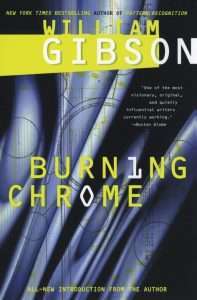 The premise is pretty simple, a photographer is sent to take photos of art deco architecture of a futuristic kind. Said photographer starts hallucinating an alternate 1980s with flying cars, massive highways, and people dressed like they’re from the planet Krypton. Anyone who has played Fallout has an idea of what this looks like as there’s the Red Rocket stations and Robbie the Robot-esque machines. His agent is surprisingly sympathetic to his losing his mind and says to basically “cool down” by watching a lot of porn and bad TV to shock his system back to normal.
The premise is pretty simple, a photographer is sent to take photos of art deco architecture of a futuristic kind. Said photographer starts hallucinating an alternate 1980s with flying cars, massive highways, and people dressed like they’re from the planet Krypton. Anyone who has played Fallout has an idea of what this looks like as there’s the Red Rocket stations and Robbie the Robot-esque machines. His agent is surprisingly sympathetic to his losing his mind and says to basically “cool down” by watching a lot of porn and bad TV to shock his system back to normal.
The actual meaning of the story is debatable and has, indeed, been debated for decades. For most people, it’s a straight up ode to the classic science fiction world as envisioned by the early Pulp writers that never came to exist. There’s no Jetsons, Flash Gordon, or Buck Rogers-esque future. Life became far more mundane and there’s a wistful nostalgia for a world where UFOs and crystal spires might have replaced skyscrapers or planes.
I maintain that Gibson was far more critical in his short story of the world as it might have been and recognized the darker undercurrent that was lurking beneath the mind of many Pulp writers. People who were as often as not reactionary as progressive. For modern day fans, we can look back to Deep Space Nine’s “Far Beyond the Stars” to see how Pulp writers of the time period were really with all of the racism and sexism (arguably pretty toned down). Every HP Lovecraft fan certainly has to deal with the fact their author probably would have found some reason to hate them.
The Gernsback Continuum has a particularly haunting scene where the protagonist comes across a couple of Aryan superman looking folk staring at one of their cities. White, CIS, het, and vaguely fascist in a way the Pulps envisioned because they didn’t see anyone outside of those norms having a place in the future. It becomes interesting to contrast cyberpunk, so-called dystopian fiction, as very much having a place for queer or people of color among it. William Gibson’s writing alone for example.
Indeed, “The Gernsback Continuum” is a story that unwittingly sets itself up as the perfect metaphor for the current ongoing culture war between the Golden Age of Science Fiction and cyberpunk that it is a gateway story. The internet is absolutely filled with so-called speculative fiction fans that are furious at the inclusion of “woke” elements that represent the kind of reactionary future that cyberpunk challenged the assumptions of. To believe in a utopia in the 1930s was far easier for people who saw it as an extension of imperialist dreams and the status quo versus a dystopia that, ironically, promised an overthrow of the present order in the 1980s.
I’ve unironically had conversations with people who state that dystopian and post-apocalypse fiction was anti-progressive. The Disney movie Tomorrowland is based around the idea that refusing to believe things are getting better was somehow antithetical to it happening. That always brings me back to this short story and what I think the real message of cyberpunk is: recognizing the systemic flaws so that they can be corrected.
Writing my own cyberpunk, I think of it as a wistful nostalgia-filled dream of motorcycles, cybernetics, and katana. It is stuff from my childhood when I watched Ghost in the Shell, Akira, and Bubblegum Crisis. Sadly, the modern day is a place where we’ve got micro-computers, the internet, megacorps, computer criminals, and the massive wealth disparity but very few of the people rising up to cast down the man. I wonder what the next age looking back on us will be.
Read The Gernsback Continuum by William GibsonThe post REVIEW: The Gernsback Continuum by William Gibson appeared first on Grimdark Magazine.
April 13, 2024
REVIEW: The Straight Razor Cure (Low Town) by Daniel Polansky
Having absolutely adored Polansky’s The Builders, Those Below, Those Above, and Tomorrow’s Children, I knew it was time to go back to where it began and read The Straight Razor Cure (published as Low Town in the American market). Like a mash up of if you unleashed Pierce Brown’s Effram from Iron Gold into the world of Peter McLean’s Priest of Bones, The Straight Razor Cure is a magnificent read.
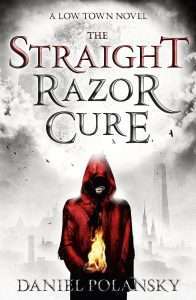 Set in Low Town, the dingiest part of a post-war city much like London at the turn of the previous century, The Warden is an ex-soldier with a big cupboard of horrid memories from a war that stretched on for years and chewed through a few generations of people. Having then worked for the Special Operations of the police force straddling the line between murderer and investigator he now runs the local drug trade from a pub his friend from the war owns. He thinks he doesn’t care about people anymore—between becoming an orphan thanks to the great plague and witnessing the war from start to horror occult finish, he’s just about done caring about more than a few people—but when children start going missing on his turf, it’s time to do something about it.
Set in Low Town, the dingiest part of a post-war city much like London at the turn of the previous century, The Warden is an ex-soldier with a big cupboard of horrid memories from a war that stretched on for years and chewed through a few generations of people. Having then worked for the Special Operations of the police force straddling the line between murderer and investigator he now runs the local drug trade from a pub his friend from the war owns. He thinks he doesn’t care about people anymore—between becoming an orphan thanks to the great plague and witnessing the war from start to horror occult finish, he’s just about done caring about more than a few people—but when children start going missing on his turf, it’s time to do something about it.
Told in a gritty, grungy first-person style with more moral greyness than you could stab a trench blade at, The Straight Razor Cure is the perfect book for grimdark fantasy fans. The protagonist’s point of view is sad, and brutal, and horrifying, and yet also funny, cynical, and poignant, with on point social commentary ringing true to this day. I love the way his friends both bring out the best and worst in The Warden, with their own goals well told through their actions within his perspective. The world is well-lived in and thought out—something I think is one of Polansky’s well-established strengths. There is true depth there, despite us only getting to really see Low Town (with glimpses into a couple of timelines there), the trench lined battlefields from the war with the Dren, and one mansion in a richer area of the city. Leaning on the reader’s knowledge of WW1, The Black Death, and a few other parts of European history makes The Straight Razor Cure very easy to lean into and lose yourself in the story as you’re not trying to constantly map an completely unfamiliar world.
The Straight Razor Cure by Daniel Polansky is exactly what you need to read if you’re a fan of grimdark. If the gruff investigation into a seedy underworld where the rich treat those below them like animals to be used and tossed away while the poor scrap to survive, and seeing a smidge of light and laughter amongst the grit, is your reading jam, then I absolutely, unashamedly, cannot express how much this book needs to be in your TBR if it is already not so.
Read The Straight Razor Cure (Low Town) by Daniel PolanskyThe post REVIEW: The Straight Razor Cure (Low Town) by Daniel Polansky appeared first on Grimdark Magazine.
April 12, 2024
REVIEW: Conan the Barbarian #9 by Jim Zub (W) and Roberto De La Torre (A)
As the “Thrice Marked for Death!” story came to its sudden conclusion (Conan the Barbarian issue #8), Conan had found himself under the sway of a trio of specters that had invaded his body and mind. Rather than allow himself to be reduced to a mindless puppet for their master Thulsa Doom, Conan marshaled one final burst of strength to turn his ancient Pictish blade on himself. The instant the sword pierced his flesh lightning struck, transporting Conan 80,000 years into the past. As issue #9 begins, a groggy and injured Conan immediately comes face to face with the fierce Pictish warrior Brule. While Conan and Brule once shared a brief otherworldly encounter during a desperate moment (Conan the Barbarian issue #4), neither have any memory of each other beyond a vague sense of familiarity. Unsure of how to handle the dangerous stranger, Brule escorts Conan to see his king in Valusia. While another familiar face awaits in Valusia, City of Wonder, so does a deadly confrontation with an unexpected opponent.
 Conan the Barbarian issue #9 launches a new story arc, “The Age Unconquered,” and also marks the return of artist Roberto De La Torre. While Doug Braithwaite’s turned in solid work for the “Thrice Marked for Death!” story arc, I suspect many readers from the Marvel Comics era of Conan the Barbarian will be pleased to see the return of De La Torre’s more classic style. Jim Zub’s narration meets the high standard set in his previous issues, but without drawing too much attention to itself this time around.
Conan the Barbarian issue #9 launches a new story arc, “The Age Unconquered,” and also marks the return of artist Roberto De La Torre. While Doug Braithwaite’s turned in solid work for the “Thrice Marked for Death!” story arc, I suspect many readers from the Marvel Comics era of Conan the Barbarian will be pleased to see the return of De La Torre’s more classic style. Jim Zub’s narration meets the high standard set in his previous issues, but without drawing too much attention to itself this time around.
Appropriately, this month’s companion essay by Robert E. Howard scholar Jeffrey Shanks details the ancient Thurian Age in which Conan has found himself, epochs before his own native Hyborean Age. Home to Howard’s King Kull and Brule the Spear-Slayer, the Thurian Age is a pre-cataclysmic era dating back to before the fall of Atlantis. Shanks covers both the setting and its inspirations, and also provides a brief introduction to the King Kull cycle of stories. While not as widely known as Conan, King Kull was actually an older character. As Shanks points out, the very first Conan story was actually a re-written version of an unpublished Kull tale.
The abrupt and inconclusive finale to the “Thrice Marked for Death!” story arc left a sour taste in my mouth, but this issue left me feeling more optimistic about the direction of the story. It has been a pleasure to see Zub introducing references to other works by Conan creator Robert E. Howard, with cameos or dialogue relating to non-Hyborean heroes and villains. Readers who enjoy Conan’s adventures are likely to enjoy Howard’s other literary creations as well, perhaps they just need a slight push. In fact, Conan the Barbarian issue #9 feels like a “backdoor pilot” to a stand-alone King Kull comic title. That being said, part of me feels it is still a bit early in the Titan Comics run to dwell so much on other Howard characters and settings when new readers have spent so little time with Conan and his Hyborean Age. Crossovers, throwbacks, and referential Easter Eggs are fun for veteran readers, I just hope new fans aren’t overlooked in the apparent push towards a Robert E. Howard-based Titan/Heroic Signatures comic universe. That concern aside, Conan the Barbarian issue #9 delivers the thrills, plunging Conan into a desperate new situation in a vibrant and exciting setting.
Read Conan the Barbarian #9The post REVIEW: Conan the Barbarian #9 by Jim Zub (W) and Roberto De La Torre (A) appeared first on Grimdark Magazine.
April 11, 2024
REVIEW: Dead Tide by Stephen Alexander North
Saint Petersburg, FL is filled with hungry soulless monsters. Also, zombies. This isn’t just me being flippant. Dead Tide by Stephen Alexander North is one of those uncommon, if not rare, zombie books which remembers the creatures were created (or, if you desire, adapted) for the purposes of social commentary. Modern adaptations of the zombie often forget the metaphor and simply make them a Macguffin for exploring the effects of trauma on humans.
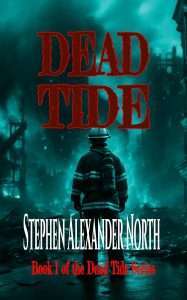 Dead Tide is more akin to the original George Romero use of zombies as Saint Petersburg, FL is used as the backdrop for an exploration of the simmering tensions existing in the United States today. When all hell breaks loose during your otherwise-typical zombie uprising (which is an odd sentence now that I think about it), Stephen A. North takes the time to examine how it impacts various classes of people. White, black, rich, poor, classy, and trashy all get their reactions gauged as things go to hell around them.
Dead Tide is more akin to the original George Romero use of zombies as Saint Petersburg, FL is used as the backdrop for an exploration of the simmering tensions existing in the United States today. When all hell breaks loose during your otherwise-typical zombie uprising (which is an odd sentence now that I think about it), Stephen A. North takes the time to examine how it impacts various classes of people. White, black, rich, poor, classy, and trashy all get their reactions gauged as things go to hell around them.
The city of Saint Petersburg is done no favors by Stephen A. North as the RL vacation spot is shown to be a place with a lot of ugly lying just beneath the surface of its glitzy atmosphere. In this respect, he successfully replicates what I liked so much about Dead Rising 2. In that video game, our heroes were forced to try and rescue greedy-stupid people from a zombie apocalypse happening in a Faux-Las Vegas. Here, the many protagonists struggle to survive a seemingly glamorous town where everyone is ready to throw each other under the bus when the crap hits the fan.
Stephen A. North deserves credit for also handling the misogyny criticism of so-much post-apocalyptic fiction with a deft hand. At first, it seems like he uses several viewpoint characters to put female characters in typical “damsel in distress” situations but I was surprised to find these are subverted. For one, the men ogling the female characters and thinking how they’re all “bitches” for ignoring them under other circumstances are portrayed as the creepy weirdos they are. Likewise, when a person is stalked by those self-same weirdos, it’s portrayed as a dangerous situation which they have to escape on their own rather than be protected from via a male protagonist. The passive sexism of many citizens is examined and condemned, which I liked.
One of the more memorable sequences in the book is where a fireman and his female associate come across a man who has apparently killed two jewelry store clerks. He’s clearly unhinged and babbling in a way which leaves it unclear whether he murdered the two women or if he just put down their zombies. Either way, the man enjoyed it because they treated him poorly because of his clothes and were attractive women. It leaves our two heroes in a precarious position about what to do since he wants to go with them.
In fact, the book is filled with memorable apocalypse moments. Other favorites included the suicidal last stand of a cop confronted with a classicist Senator, the accidental shooting of a child during a vigilante killing spree, and the only people who have a grasp on what the hell is going on being individuals who have seen a zombie movie before. The latter adds a bit of much-needed levity as it’s my own personal bugbear to have zombies always be something “new and unexpected” in fiction.
My favorite scene in the book? A terrible moment where a child is revealed to have been bitten and the people who want to put him down find those who love him willing to protect him with lethal force–a perfect tragedy for a zombie apocalypse. Is the book flawless? Sorry, no. Readers should be warned the book takes a little time to get heated up and skips around too much at the beginning. Only a few pages are spent every chapter before switching perspectives to another character. While the book helpfully marks whose perspective is being moved to at the beginning of each chapter, it still was very confusing at the start. I would have preferred if Stephen A. North had done longer chapters, so we knew each protagonist very well before moving back and forth.
Nevertheless, I am going to say Dead Tide ranks up there with the early The Walking Dead issues for my favorite zombie apocalypse story. The characters are likable, the storytelling tight, the body-count high, and there’s something said about real-life (specifically, class and race relations in America). What more could I ask for?
Read Dead Tide by Stephen Alexander NorthThe post REVIEW: Dead Tide by Stephen Alexander North appeared first on Grimdark Magazine.
REVIEW: Fallout
Last Updated on April 11, 2024
Fallout is the latest TV series from Amazon Prime Video and is the streaming giant’s attempt to cash in on the success of the videogame series from Bethesda which has sold millions of copies across the world and achieved critical acclaim. With HBO’s The Last of Us, and Netflix’s Arcane proving that videogame adaptions can be some of the best shows out there, will Amazon’s shiny, new show hang with the big guns or wilt in the light of a nuclear bomb? Fans of the game can breathe a sigh of relief and newcomers need to prepare to be entertained – this will be your new favourite post-apocalyptic show.
 Fallout is brought to us by Jonathan Nolan (Westworld, The Dark Knight, Interstellar) so it’s in steady hands and the Amazon budget allows the series to match the tone, visuals, and general feeling of the games. Based in a world decimated by a nuclear holocaust, some humans dwell in vaults, beneath the surface in Los Angeles 2296 and our protagonist, Lucy, needs to head to the surface to find her father. This starts her on a journey of discovery with the R-rating well-earned as she faces the horrors of the surface world and begins to understand some of the horrors of her own. One of the best things about the games is being able to control the character’s behaviour and it is interesting to see Lucy develop throughout the series as she starts off innocent and is slowly shaped in different ways by her environment and her discoveries. She meets some incredible characters and the standout is The Ghoul played by Walton Goggins. There is more to his character than seen in the trailers and his story is one of the best pieces of the series.
Fallout is brought to us by Jonathan Nolan (Westworld, The Dark Knight, Interstellar) so it’s in steady hands and the Amazon budget allows the series to match the tone, visuals, and general feeling of the games. Based in a world decimated by a nuclear holocaust, some humans dwell in vaults, beneath the surface in Los Angeles 2296 and our protagonist, Lucy, needs to head to the surface to find her father. This starts her on a journey of discovery with the R-rating well-earned as she faces the horrors of the surface world and begins to understand some of the horrors of her own. One of the best things about the games is being able to control the character’s behaviour and it is interesting to see Lucy develop throughout the series as she starts off innocent and is slowly shaped in different ways by her environment and her discoveries. She meets some incredible characters and the standout is The Ghoul played by Walton Goggins. There is more to his character than seen in the trailers and his story is one of the best pieces of the series.
The world of Fallout looks stunning. It stands up there with the best of them and is money well spent by Amazon. We are used to see wastelands and post-apocalyptic settings (The Last of Us, Mad Max, Silo) and the environment is incredibly designed to represent the games with recognisable weapons, stimpacks, and more for the superfans to spot and beauty in decay for newcomers. Like the games, the world is full of interesting characters with their own motives and the series earns its R-rating with gore, swearing, despicable characters and more to appeal to our grimdark fans. It’s not quite mind-blowing madness like The Boys but they certainly nailed the tone of the series for fans of the game. The joy of the game is exploring the world and following mysteries and that’s what happens here through multiple threads and the series gets better as it goes on.
Fallout is sure to be a nuclear hit with audiences. It’s dark, funny, gory, and an absolute treat for sci-fi fans who like a bit of gore and nightmares in their future. It is another example of stories from games being developed with true care and attention and whether you are a gamer or not, Fallout is a series well worth getting out of your vault for and enjoying the ride. It won’t be a waste of your time and it already looks like a second series is on the way!
Watch Fallout on Amazon PrimeThe post REVIEW: Fallout appeared first on Grimdark Magazine.
April 10, 2024
REVIEW: The Butcher of the Forest by Premee Mohamed
Veris Thorn has seen death. She had survived the war and the tyranny that never ended. As a woman nearing forty, she knows suffering. It is why she cherishes her remaining family and keeps a low profile. However, the tyrant king has called upon her. As the sole person to have entered the forest of Elmever and survived, Veris is tasked with rescuing the tyrant’s lost children. But these woods hide more than monsters. The woods itself possess a power to expose fear and spawn nightmares. To save her family, Veris will enter these woods and face hell once more. Premee Mohamed unleashes a startling and tragic tale in The Butcher of the Forest.
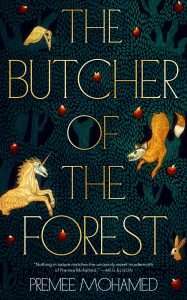 Veris Thorn in The Butcher of the Forest is an excellent portrayal of a traumatized character. The story of her past is slowly and almost sparsely revealed throughout the novella. Each fragment of her life is like finding a clue and unlocking a mystery. She is a character a reader wants to know more about.
Veris Thorn in The Butcher of the Forest is an excellent portrayal of a traumatized character. The story of her past is slowly and almost sparsely revealed throughout the novella. Each fragment of her life is like finding a clue and unlocking a mystery. She is a character a reader wants to know more about.
The strong characterization in Veris Thorn intensifies the horror elements in The Butcher of the Forest. Since the reader is provided snippets of Veris’s first time in Elmever, we get to know both the younger and present-day Veris. Back then, she was stronger and braver. Present-day Veris has lived through more trauma and developed different fears. The woods is unsettling in both timelines.
“I am no adventurer, no warrior, no soldier. The tyrant should have sent some giant in his employ.
Ah, but the giant would never have returned.”
Premee Mohamed lightly scatters backflashes of when the Tyrant King first invaded Veris’s home. How the tyrant stole power deserves its own full story. The Tyrant’s rule portrayed in The Butcher of the Forest is its own nightmare.
The worldbuilding in The Butcher of the Forest is vivid. In many ways, Veris is a prisoner to her own culture. She is an example of what guilt feels like for not complying to social expectations. The magic system is clever and adaptive. The book could have been longer.
The Butcher of the Forest is largely psychological horror with atmospheric elements. It is a swift and dark narrative of Veris Thorn’s life. She offers a unique perspective of a traumatized character. The woods has a dominating presence. The Butcher of the Forest never quite crosses the absolutely terrifying threshold but is a captivating story all the same.
Read The Butcher of the Forest by Premee MohamedThe post REVIEW: The Butcher of the Forest by Premee Mohamed appeared first on Grimdark Magazine.
April 9, 2024
REVIEW: The Angel of Indian Lake by Stephen Graham Jones
Four years have passed since the events of Don’t Fear the Reaper, the second volume in Stephen Graham Jones’ Indian Lake Trilogy. As The Angel of Indian Lake opens, Halloween is coming to Proofrock, Idaho, but—still scarred by the Independence Day Massacre of eight years ago and the bloody rampage of serial killer Dark Mill South’s so-called “reunion tour” of four years past—the picturesque lake town is doing everything it can to downplay the spooky season. Fresh out of prison for a parole violation, Proofrock’s perennial scapegoat Jade Daniels is likewise keeping a low profile. Back in the only home she knows, as flawed and unwelcoming as it is, she ekes out a quiet life as the local high school’s history teacher. Proofrock is one town where the crimes of the past refused to stay buried, however. When a sheriff’s vehicle lost in the mountains during Dark Mill South’s killing spree is rediscovered, a high school student’s quad-copter drone footage also reveals a number of fresh corpses in the immediate vicinity, including students of Jade’s. Try as she might to avoid becoming sucked in to the bloody affair, a subsequent daylight murder on the high school’s doorstep demands Jade’s immediate attention. Chaos erupts, bodies fall, and the legendary Angel of Indian Lake from Proofrock’s frontier days lurks around the periphery.
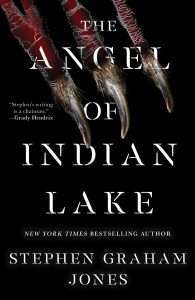 Much like Don’t Fear the Reaper, The Angel of Indian Lake takes place in an extremely compressed span of time: immediately before, during, and after Halloween. The pacing is similarly relentless, but the stakes are higher than ever. Not only is Proofrock itself facing an existential threat, Jade must put herself in harm’s way to to protect the few surviving residents of Proofrock that hardened and traumatized Jade has allowed herself to love. While she has become somewhat (understandably) ambivalent to horror movies after being immersed in so much real-life carnage over the past eight years, once again Jade puts her encyclopedic knowledge of slasher flicks and their tropes to work in an effort to live to see another day.
Much like Don’t Fear the Reaper, The Angel of Indian Lake takes place in an extremely compressed span of time: immediately before, during, and after Halloween. The pacing is similarly relentless, but the stakes are higher than ever. Not only is Proofrock itself facing an existential threat, Jade must put herself in harm’s way to to protect the few surviving residents of Proofrock that hardened and traumatized Jade has allowed herself to love. While she has become somewhat (understandably) ambivalent to horror movies after being immersed in so much real-life carnage over the past eight years, once again Jade puts her encyclopedic knowledge of slasher flicks and their tropes to work in an effort to live to see another day.
As with the first two books in the Indian Lake Trilogy, Jade remains the wounded but defiant heart of the narrative in The Angel of Indian Lake. Each of the books depends heavily on their nuanced portrayals of a misunderstood and neglected misfit that has a tendency to vehemently reject the few helping hands extended in her direction out of fear of betrayal. Misanthropic characters are difficult to get right, and are always at risk of being found frustrating or unlikable by readers, but Jade has always been rendered with such aching empathy that the audience can’t help but share her fears and see past the bulletproof shell she has constructed around herself. Jones describes her as the girl whose heart is too big for her body, and the success of the books (and popularity of “Jade Daniels is my Final Girl” T-shirts) has made it clear that she resonates with many readers. At her core, Jade remains the same complicated character that won over readers with her first appearance in My Heart is a Chainsaw, but she has matured and grown. She’s still as rebellious as ever, but time, therapy, and the support of her chosen family have rounded off some of her edges, creating a more polished and even-tempered version of herself. And where previously readers were only provided occasional glimpses directly into Jade’s mind via horror film-related essays submitted to her high school high school teacher, The Angel of Indian Lake shifts from the third person to a first-person perspective, with Jade herself as the narrator. Constantly under pressure as she struggles for her life, Jade’s mind runs a mile a minute, thoughts swirling with movie trivia, hopes, fears, assumptions, misinterpretations, and jumped-to conclusions. Her stream-of-consciousness perspective is sometimes a challenging one, as it’s occasionally difficult for the reader to distinguish actual events from flights of fancy, but the intimacy of her perspective enhances the experience. Jade and her horror-drenched worldview are the highlight of these books, making the move to first person perspective a wise storytelling choice.
While it was certainly present in the previous volumes, Jones’ masterful and empathetic characterization of supporting characters is particularly noticeable in The Angel of Indian Lake. Like Jade, her best friend Letha and her husband Sheriff Banner have also grown into themselves while doing their best to cope with Proofrock’s numerous tragedies. While the characters’ dialogue is by turns moving, wry, or devastating, Jones also manages to communicate so much through understatement, words left unsaid, and subtle body language.
In the Acknowledgments section of the book, Jones frankly discusses the challenges he faced writing The Angel of Indian Lake. While it must have been an intimidating task attempting to live up to the fan expectations accumulated with the first two books, it was surprising to see how little material he had prepared ahead of time. None of this blank space was obvious while reading the book, the ease with which Jones picked up plot threads from the first two volumes and interwove them with new events made it seem like he had everything exhaustively planned from the start. Minor characters have surprising destinies and seemingly throwaway elements receive unexpected payoffs. Jones makes executing a satisfying horror trilogy look easy, in a way that very few authors to date have managed.
With The Angel of Indian Lake, Jade Daniels’ story gets the ending it deserves. Expect award nominations to follow.
Read The Angel of Indian Lake by Stephen Graham JonesThe post REVIEW: The Angel of Indian Lake by Stephen Graham Jones appeared first on Grimdark Magazine.
April 8, 2024
REVIEW: Diavola by Jennifer Thorne
Jennifer Thorne brings supernatural terror to an already dysfunctional family vacation in Diavola, which follows the Pace family on their ill-fated Italian holiday. Although the family’s surname translates to “peace” in Italian, they are not given a moment’s rest as their rental home turns out to be an infamous haunted house, feared and shunned by the local populace.
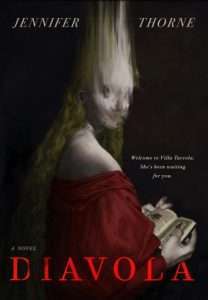 The lead protagonist in Diavola is Anna Pace, the black sheep of the family who is treated like an outcast and can never live up to their expectations. Rightfully or not, Anna takes the blame for many of the family’s misfortunes. Thorne reaches a T. Kingfisher-level of narration with Anna: she is smart, funny, and so vibrantly engaging that it’s impossible not to love her.
The lead protagonist in Diavola is Anna Pace, the black sheep of the family who is treated like an outcast and can never live up to their expectations. Rightfully or not, Anna takes the blame for many of the family’s misfortunes. Thorne reaches a T. Kingfisher-level of narration with Anna: she is smart, funny, and so vibrantly engaging that it’s impossible not to love her.
As in her previous novel, Lute, Jennifer Thorne both embraces and upends the trope of naïve, unbelieving Americans who face a supernatural threat in an historic European setting. Diavola exploits this clash of cultures to great effect, skillfully walking the line between camp and deathly serious horror. At its best, the laugh-out-loud moments in Diavola are worthy of Oscar Wilde’s classic short story, “The Canterville Ghost,” which also features an American family who take up residence in an old European haunted house while expressing a stubborn disbelief in local legends.
Although this approach risks becoming self-parody in less capable hands, Jennifer Thorne’s incisive, sardonic writing strikes just the right balance between humor and horror. She is also an expert at characterization: a large part of what makes Diavola work so well is that the Pace family is so believable in their dysfunction.
I especially enjoyed the final third of the novel, where Thorne brilliantly ties together the various threads of the story while delivering plenty of unexpected twists. I was delighted by Anna’s character growth in this final part of Diavola as she addresses issues of loneliness and belonging while fighting back against the embodiment of fear itself.
Altogether, Diavola is a must-read for horror fans, delivering a thrill ride that is equal parts fun and terrifying.
Read Diavola by Jennifer ThorneThe post REVIEW: Diavola by Jennifer Thorne appeared first on Grimdark Magazine.
April 7, 2024
REVIEW: Lost Ark Dreaming by Suyi Davies Okungbowa
In Lost Ark Dreaming by Suyi Davies Okungbowa the seas have risen on the coast of Nigeria. Inside the Fingers—five towers submerged up to level 34 built to house the people who could afford a room and escape the global catastrophe—what feels like one of the last bastions of humanity dwell amongst crumbling technology trapped into class-based levels. In a novella that feels a lot like the author took Snowpiercer, stood it up to point at the sky, submerged the back end of it, and played it out with a new cast in a different part of the world and culture, Lost Ark Dreaming delves deep into a lot of modern themes around the way we treat and mistrust and discriminate against each other in a beautiful, poetic, dreamlike written way.
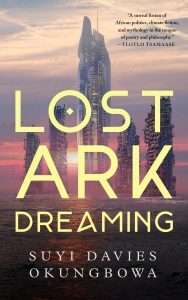 In this post-environmental-apocalypse novella, Lost Ark Dreaming is told through the eyes of Yekini, a technician in the corporation / government department responsible for parsing communications to send to those in command on the upper levels of her tower. Late to work, again, she is tasked (as opportunity or punishment) with going down to the submerged levels to help investigate some damage to an airlock. Ngozi, a higher level member the corporation, gets put on the same job, something he sees as below him as he strives to climb the corporate ladder. Tuoyo is the foreman of the level and airlock in question, and sent the message upstairs to notify them of a breach in the airlock—something feared by the tower as the terrifying Children try to gain access from the dark waters outside.
In this post-environmental-apocalypse novella, Lost Ark Dreaming is told through the eyes of Yekini, a technician in the corporation / government department responsible for parsing communications to send to those in command on the upper levels of her tower. Late to work, again, she is tasked (as opportunity or punishment) with going down to the submerged levels to help investigate some damage to an airlock. Ngozi, a higher level member the corporation, gets put on the same job, something he sees as below him as he strives to climb the corporate ladder. Tuoyo is the foreman of the level and airlock in question, and sent the message upstairs to notify them of a breach in the airlock—something feared by the tower as the terrifying Children try to gain access from the dark waters outside.
With very clear messaging around the way our society—and based on where the author seems to have been schooled in their postscript, American society in particular—fails those in the lower and middle classes, and others and excludes people we don’t understand, and how modern governments treat their people, Lost Ark Dreaming maintains a theme of rebellion and breaking free of this trap we’ve built for ourselves throughout. The three perspectives each seem to grow into that vein at their own pace, helping maintain the theme throughout the book, and building a sense of hope through sacrifice as we approach the end.
There is also a very spiritual feel to this story, with the Queen Conch, historic interludes, and some poetry adding a very different experience to what you may expect to find in other books using a similar vehicle to deliver the story. For me, a standard bloke from Sydney, Australia, this really appealed to me and nicely pushed the boundaries of my wheelhouse of reading in a way I really enjoyed—though I am more than certain there are additional themes in the book that I missed that people closer to the countries and cultures written about would enjoy more than I am capable of.
Beautifully written, paced, and imagined, Lost Ark Dreaming is a novella I hope every fan of dystopian post-apocalyptic fiction picks up and tries out. There is plenty in there for readers from all walks of life.
Read Lost Ark Dreaming by Suyi Davies OkungbowaThe post REVIEW: Lost Ark Dreaming by Suyi Davies Okungbowa appeared first on Grimdark Magazine.



